Hailing from a small New England town tucked away in the white mountains of New Hampshire, I’m quite familiar with “green space.” I am actually more unaccustomed to living anywhere even close to a big city. Nearest to home is Boston—a two hour and fifteen minute haul. Therefore, one significant change in living in London is the disappearance of the monstrous mountains, endless trees, and, of course, fresh, crisp air. However, this wondrous city never ceases to surprise me. The parks I have visited are, as many can agree, blessed sanctuaries. I unintentionally have separated the innumerable parks into two groups: the larger, well known ones and the smaller, more secluded ones. Each sort of park provides a different environment.
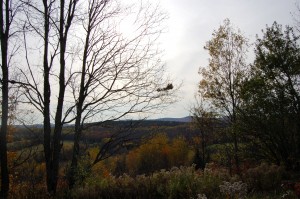
New England’s expansive green space (personal photo)
Of the “royal” parks (they’re labeled as such on London’s website) I have enjoyed Hyde Park and its nearby neighbor, Kensington Gardens; the Green Park, St. James’s Park, and the Reagent’s Park. It is at times entertaining to get lost in these massive parks. As a person wanders, he or she delves deeper into the green refuge and furthers him or herself from the city’s bustle and grime. I enjoyed exploring the incalculable monuments, memorials, and museums that materialize in these sprawling parks. These sanctuaries are not just for people to escape the city chaos; they serve as a safe place to preserve the surrounding area’s detailed history. I researched Hyde Park extensively and the pride the Londoners hold for the history of the park and the area itself is immediately evident. Speaker’s Corner, Rotten Row, Serpentine, the Wellington Museum—they all are housed within Hyde Park to be preserved and honored. For one, Hyde Park Corner Tube Station boasts tunnels decorated with elaborate murals illustrating the area’s history. How that for an introduction?

Hyde Park
The smaller parks have their own benefits. Scattered throughout the city and hidden in unexpected areas of London, these parks also present its community with an opportunity to take a break from the stresses of life. Although, they seem to enact stricter regulations, the parks offer a one with a place for relaxation, tranquility, entertainment, and community. Not to say these features do not apply to the larger parks, but these small parks seem much more intimate and more closely connected to the residents of the area. Also, these parks oftentimes possess a number of historical monuments but to a lesser degree in comparison to the royal parks. Even so, all of these parks in London, regardless of their size, give people a place to take a break from city life or just life in general. And to me, I particularly like that each one prides itself on its distinctive, detailed history.

Bedford Square, the park just down Gower Street
Categories: 2010 Mary
Tagged: Green Space, Hyde Park, parks, Royal Parks
The fact that London is 25% green absolutely boggles my mind. I love that the English place such an emphasis on green open areas, even in the middle of their capital. One of my favorite days during our trip here incorporated an afternoon in Regent’s Park. After my walking tour I went to the park, armed with a book and a sunny day. I then sat there for an hour and read. And while I did not get much actual reading done, I experienced something far more important – the breakdown of English cultural barriers. It started when someone’s puppy wandered over to me. Instead of calling back their dog, the owner just smiled at me and kept going, trusting that I would respect their pet and that it would go back to its owner when it so desired. This complete warmth towards a total stranger is not something I had experienced yet in the usually reserved London public sphere.
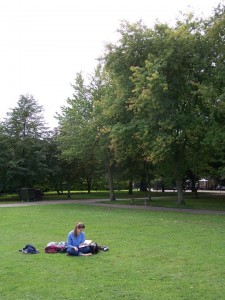
This breakdown of reserve was apparent the more I walked around the park. Everywhere I looked there were older gents playing with their dogs, mothers entertaining their children, and couples walking around paying more attention to each other than to their beautiful surroundings. While Kate Fox always talks about the English “social dis-ease” the atmosphere of Regent’s park was completely the opposite. Both at Regent’s Park and at St. James’ Park the wealth of examples of the English comfort, not with just themselves, but with those around them, showed more warmth than I am accustomed to in Los Angeles. It is almost as if the British use their parks as a place to escape the normally tight social boundaries regarding affection and interaction with strangers.
Parks also serve to remind the English that they’re inherently country folk. In times of crisis throughout English history (like the Plague), those who could afford to would flock to the countryside and to their agrarian roots. The English find safety in green open spaces and in city filled with smog and where everyone is in a constant rush, there has to be an emphasis these parks. These parks help make London English and help to remind English Londoners that they are English.
Categories: 2010 Amy
Tagged: London Parks, parks, The Regent's Park
As we have all noticed, pubs are an integral part of English life. They also make for a good laugh when walking down the street and you realize a particularly bizarre pub name. My experiences in pubs thus far have been varied and I’ve learned a few things.
#1: You can’t care if people are looking at you funny because you’re loud. A couple of times, I’ve been with a group of people and we have been rather loud, not surprisingly. Of course it attracts attention, especially if has been in the earlier part of the day. For example, after the walking tours were finished, my group went to a pub (The Globe) outside of Covent Garden to have a celebratory drink. An older couple was sitting near us and I’d notice that they sent us side glances every once in awhile. (In our defense, we did try to sit in a back corner so that we wouldn’t- hopefully- be too disturbing.) While we were being loud, I have noticed on my other pub visits that loud isn’t always a problem. It’s a space where people can be more relaxed and English reserve is often lessened. So, I was left wondering whether the side-glances were a result of the fact we were loud Americans (typical!), 20-somethings, or a combination of both.
#2: The Irish are more outgoing, supposedly. A couple of weeks ago, I was in a pub when an Irish guy (James) started to talk to us (and constantly complained about how the English are a lot more stand-offish, as well as about how I don’t have a strong accent). At this point, I had this idea of pubs as solely a place for mates to get together to catch up or after work to wind down. Instead of being the ones who attempted to start a conversation, we were engaged, which caught me off guard. Afterwards, I was hoping that maybe some of the other experiences that I had at pubs would be more open. Nope. They reinforced the idea that this was an exception to the rule.
#3: Offering a pint is polite, but so is refusing. When I’ve been in groups and we’ve offered to a drink to the bartender, they’ve either accepted and then not charged us or refused us. In the later example, I think she was so caught off guard that we offered. The last time we were in this particular pub, we had been in a hurry and unable to “play by the pub rules.” This and her surprise at the offer because of the fact most tourists don’t know about this particular bit of pub etiquette is what, I think, played a major role in her refusal. I look forward to seeing what happens in other pubs.
#4: Don’t be in a hurry. Pubs are a place to relax and unwind with friends, not grab a quick bite between activities. They are meant to be places where time slows and happiness increases, not where stress creeps through.
#5: Orwell was right. The perfect pub doesn’t exist. I’ve enjoyed visiting different ones, but I haven’t found my ideal English pub where I want to go back and become a regular, that has my favorite cider, the best chips in the world, little rooms where no one disturbs anyone, interested workers, near a tube/bus stop, and that the worst drunks don’t visit. Yet, I think the perfect pub would lose its charm. One of the great things about the different pubs I’ve encountered so far is that they all have their charm and I would want to return for different reasons. If you take all of the traits that I’ve enjoyed the most and put them into one pub, I think I’d find it boring.
I look forward to continuing the quest for my perfect pub. I’m thinking the name will be something along the lines of the Unicorn of Albion…
Categories: 2010 Stephenie · Pubs
September 19, 2010 · 2 Comments
In America I have always had the feeling that one thing or one aspect you do not talk about at school is religion and your personal religious beliefs. I believe this stems from the thought that people’s feelings will be hurt, that it is too personal. I say “rubbish” to that way of thought, if there is one thing I have appreciated on this trip is the amount of religious discussions we have had in our group. Never had I had full on discussion about religions and my own personal religious beliefs with my own peers before this month. So, I would like to take the time so say Thank you Britain for allowing us to be a little bit more open in our beliefs.
Throughout this month we have visited a number of Cathedrals, Churches, and Religious Centers. As a Catholic I definitely identified more with the Cathedrals and Churches we visited. My favorite of these was St. Paul’s Cathedral. It is a magnificent structure that really attests to the power and might of humans. When I see gorgeous structures like St. Paul’s I always wonder how a great architects mind, like Christopher Wren, see when they see an empty space. People who are born with the ability to express through creation always impress me and make me just a little bit jealous.
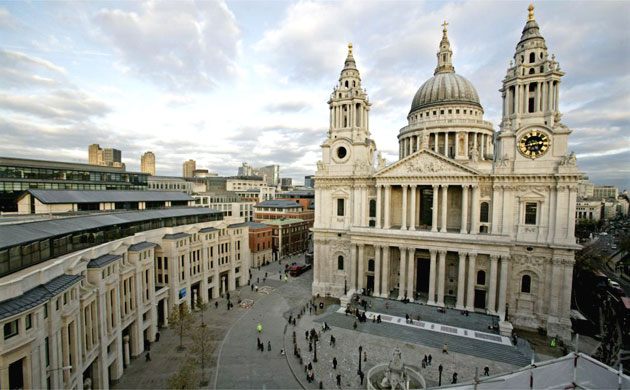
On other note I was really uneasy and uncomfortable with Britain transforming these Cathedrals and Churches from spiritual dwellings into semi- museums. I feel it makes them very impersonal and looses a little bit of its beauty. However, on the other hand it is also a way for people of different sects and beliefs to learn and experience these religions. I guess with every decision made there is a positive and a negative.
After seeing all these really old places where kings and queens were crowned we moved on to religions that I know little to nothing about. The first of which was the Mandir. Let me just say that before this day I had never even seen what a Hindu place of worship looks like or known much about the religion. I was surprised to see another magnificent place of worship, with such high precision of architecture. The religion itself is radically different from what I am use to but nonetheless I felt welcomed and curious at the same time. Perhaps, what struck me the most was the fact that in the place of worship and veneration women and men are separated.

After the Mandir we visited a Mosque in the East End. Unlike my learning experience within the Mandir I felt my opportunity to learn about Islam and the community was lost in such a quick and impersonal tour. The Mosque was pretty well developed but the interior was not as interesting as I had expected it to be. I was actually excited to wear a head covering to visit this temple just because I had never been required to do it.
The last place of worship we visited was a Synagogue. This was not my first visit to a Jewish temple but it was very different to my last experience. In my last experience I attended an actual service and I had to go through security check prior to entering the premises. In the actual services I felt like a complete outsider I hardly knew what was going on. This time, however, we were expected. We did not have to go through security and were given a very comprehensive lesson on the history of Jewish people in England. All around it was a great experience.
From all my visits to these largely different and sometimes similar sects of religions I came to my own conclusion about religions in general. Religions will always be necessary as long as man live. Religions were at first the first form of government for communities stipulating how to act, how to work, how to live as a unit, etc. Now religions provide for man a sense of purpose beyond our own physical existence, they attempt to explain the unexplained, to give hope, to give a sense of identity, and lastly to create a sense of community. Therefore, I think that all religions will continue to existence as long as man lives.
Categories: 2010 Jamie
Tagged: Cathedral, Mandir, Religion
September 19, 2010 · 1 Comment
I think that one of my favorite things about London is its parks. I have mentioned before in some of my other posts that I don’t think I could ever live in a big city – the crowds and the hurry and the size just stress me out too much. I’ve found that parks are one of the few places where you can have space to walk down a path in a straight line without having to dodge and weave and bump into people and say “sorry.” I’ve found that parks are also a place where you are pretty much guaranteed a place to sit, and you don’t necessarily have to be within ten feet of another person either. It’s lovely that London thought to create places where there is enough space for large amounts of people to be, unlike on the tube or on the streets, where there just simply isn’t. The peace is more beautiful to me than all the trees and flowers and landscaping, although that is pretty too, and a nice break from the architectural chaos of London. I think you really could lose yourself and forget about the city for awhile in parks if you wanted to. When I visited Hyde Park*, I took the following two pictures of the lake:
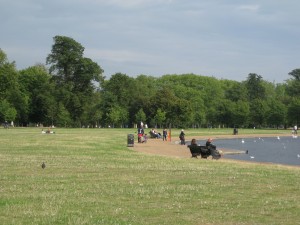
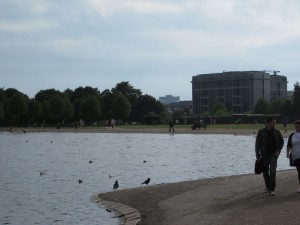
Oh right, the city. There it is. These two pictures seem a bit incongruous; you could probably lie, and tell people that they are different lakes in different places, and they might believe you.
It seems that parks have several different uses for people in London. The first park I visited was St. James Park, and there I joined many other people picnicking on their lunch break. This seems much more enjoyable than inhaling a sandwich on the tube, and if I ever were to work in London, I would want a job where I could eat lunch in the park. The other side of the bridge at St. James however, toward Buckingham Palace, is much more touristy. I was alerted to this by the presence of an ice cream stand, and chairs that you could pay to sit in. I don’t see this as a problem though, as tourists, I am sure, also need a break from the city. Other uses I have seen for parks include
dog walking
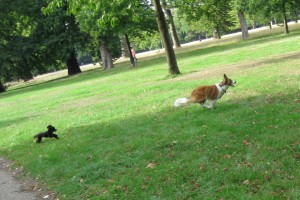
dates

studying

or just being alone and doing whatever you want.

A last really important use for parks, I think, is creating a safe space for children. Professor Qualls brought up this point on the Bloomsbury walking tour, when he took us past the Coram playground, and explained that it was fenced off because you were not allowed in unless you had a child. I saw this again at the Princess Diana Memorial Playground in Hyde Park. It was fenced, plus there was a guard at the door checking people. I witnessed a man come up to the guard and ask if he could see if his wife was in there with his son. The guard told him he could not go in. While this man probably was the father of a child, it is also possible that he could have been a child snatcher, and I personally am a fan of this playground rule that protects children against them. I don’t think we have this in America, or at least I’ve never seen it. At the playground near my house, high school kids smoke pot after school.
While I am excited to move to Norwich and escape the city more or less permanently, when I do return to London, parks will be on my list of places to revisit.
*Note: I am not exactly sure where Kensington Gardens ends and Hyde Park begins. This lake could very well technically be in Kensington Gardens. My apologies to Kensington Gardens if this is the case.
**Note also: all photos in this post are mine. Sorry if you think I’m creepy for taking pictures of random people. It was all in the spirit of academia.
Categories: 2010 Kaitlin
Tagged: Coram Playground, Hyde Park, Kensington Gardens, Princess Diana Memorial Playground, St. James Park
The parks in London, as people have already noted, are places of beauty and enjoyment. Yet, they are not all created equal, well, no, used equally. When relaxing in various ones, I noticed that some were more touristy. In fact, within some, one area was more likely to be touristy that an other.
My first introduction to a London park was when we had class in Russell Square. Clearly, people weren’t used to seeing a group of students (much less Americans) in August discussing various ideas about immigration. Yet, I can’t imagine being at UCL and not using the space for at least small study groups, if not classroom discussions when the weather turns nice.
I adore the idea of small squares littered throughout the city ready for use whenever someone wants an escape from the business and chaos of the city. Of those I noticed, the squares I most wanted to go into were locked and only accessible by the area’s residents. I have mixed feelings on this. On one hand, it’s great for residents to have a safe place to go with their young children or a quiet place where they don’t have to worry about tourists wandering through talking loudly (oops). On the other, why shouldn’t these spaces be opened up for everyone? It feels like one more thing that add to English hypocrisy: they want to pretend when it’s convenient that class doesn’t count, but it seems to exist in these situations when the restricted squares seem to be in areas where income looks to be higher.
For the actual parks, my favorite has been Kensington Gardens. I loved the duality of the park: one side was quiet and peaceful and the other was busy, well, as busy as a park can be. Residents played with their dogs as tourists wandered through taking photos and trying to find the actual park, Hyde Park. Hyde Park was also rather enjoyable, but was far busier on the day I visited. Granted, searching for the Peter Pan statue also lends the visit to being centered around the busier areas. I enjoyed walking through Kensington and observing people and how they interacted with the space (mostly walking their dogs or playing fetch with them, as well as a few taking their young children out for a walk). In Hyde I felt like I was only there to check it off of my list of “Things To Do in London.”
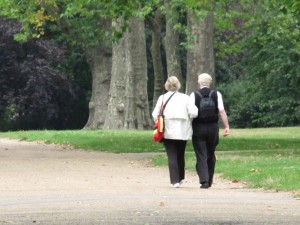
Regent’s Park, while a lot like Hyde in some regard also demonstrated this dualistic atmosphere. The park seemed to have a few tourists wandering through (especially as you got closer to the Zoo and in the more French style areas), but it also had a lot of Londoners, some out walking and others with their family (or dogs). I much preferred the areas that were mostly charming (and alarmingly uneven) paths, where others were walking with their dogs. The other thing that I liked about Regent’s was how family friendly it was. There was a playground that was obviously popular among families with young children.
I’ve enjoyed the parks that I’ve visited and they’ve helped convince me that London is actually my favorite city in the world because of their place in the life of the average Londoner (or student visiting for the month): they’re key to staying sane here. I thrive on the chaos of the city, but sometimes nothing is better than a quiet stroll through a park or an hour reading in a square. I hope that as I venture to other places in England that I will be able to go to a few other cities’ gardens/squares/parks and see how they differ.
Categories: 2010 Stephenie
Tagged: gardens, Hyde Park, Kensington Gardens, parks, Regents Park, squares
As you all probably know, the Jewish high holidays, Rosh Hashana and Yom Kippur were over this past week and a half. The combination of these days and being in a new place has, along with making me more than a little homesick, made me curious to explore Jewish communities in London. I was lucky enough to encounter three very Jewish communities here: the West London Synagogue, which I attended for Rosh Hashanah services, the Liberal Jewish Synagogue, for Yom Kippur services, and The Central London Synagogue, which we visited as a group.
As with the various Jewish communities in the States, these three synagogues were drastically different from one another. The Central London Synagogue (where I did not attend a service), is Orthodox. I could tell the moment that we walked in, based on the layout of the sanctuary, with separate seating for men and women. The West London Synagogue is Reform, but I did not experience the type of Reform Jewish service that I am accustomed to at home: it was over all more “traditional reform,” with less music, and even less Hebrew than I prefer. The Liberal Jewish Synagogue’s service was easily my favorite, probably because it was the most like the synagogue that I grew up attending. There, the audience sang along with the choir and the rabbi. Some folk music was incorporated, and I heard and read along with more Hebrew than at the Reform service, although many prayers were still said in English. I finished a very personally fulfilling Yom Kippur by taking a walk in Regents Park and talking with my family on the phone.
But what struck me more than the disorientation I experienced as I explored the various synagogues, was how much felt familiar. Fundamentally, I experienced the same prayers, similar music, a few people conspicuously wearing mesh sneakers with their dresses or suits, so as not to wear leather on Yom Kippur, and many congregants greeting each other enthusiastically with “Shana Tovah,” (have a good new year). (Even many aspects of the Orthodox synagogue were very familiar, though I do not agree with much of the Orthodox viewpoint.) It made me think of what I was often told by adults when I was younger, but never gave much thought to: wherever in the world I go, I can find something familiar by visiting a Jewish community.
Despite (and maybe because of) the familiarity, I was startled near the end of the first service I attended to hear a prayer for the queen. I wondered if it was historically based, maybe something required in all religious services in England during a certain time period. But this added prayer turned out a difference that demonstrated another similarity.
Our guide at the Orthodox synagogue that we visited explained a stained glass window that honored the Queen by telling us that a prayer for the Queen is added because the safety of the Jews always depends on the safety of the country in which they are living. Therefore, the prayer for the Queen corresponds to the prayer briefly said at my synagogue at home for peace within “our nation.” So saying a prayer for “our Sovereign Lady Queen Elizabeth,” is just a very English way of following a custom that I have seen in services for my whole life. I wonder how many other differences in Jewish customs and synagogues worldwide can be traced back to the same ideas as one another.
Categories: 2010 Emily · Uncategorized
Tagged: Judaism, Regligion, Synagogues
September 19, 2010 · 1 Comment
Frankly, I just don’t get it. I flat out do not understand how the Brits have (supposedly) built their entire social culture around pubs. You feel awkward going in, all you want to do is apologise and the food and drink are usually overpriced. That has been my experience, at least.
To be fair, I don’t plan on (once I turn 21) frequenting bars in the States. Like pubs, these are usually loud, overcrowded places mostly filled with people who have had a few too many. I’m the sort of person who would rather share a bottle of wine over dinner than specifically go out to a place to get drunk, as I think many people do.
My most positive pub experience came about after I had spent the afternoon alone going to museums. I was heading back towards the Tube from the Tate Britain when I realised that I was extremely hungry. I looked around to find some food (absolutely dreading the idea of ANOTHER sandwich from Planet Organics) and the first decent-looking place I found happened to be a pub. It was in a good area, close to the Tube, well-lit and not crowded, so I went for it. It was the White Swan Pub (photo: http://www.localdatasearch.com/london/victoria/public_houses_inns/the_white_swan-10005712)

As I walked in the door, panic began building in my mind. I mentally flipped through the pages of Watching the English, trying to remember pub protocol. Seat yourself . . . order at the bar . . . But how do I claim a table without leaving my stuff there to be stolen? Do I move the place settings or something to subtly signal that I have chosen the seat as my own? Should I only order a drink first or food at the same time?
Finally, I just approached the bar and asked rather nervously “Erm . . . do I order food up here as well?” The server gave me a lookover and then responded “Yeah.” Without even looking at the menu, I asked for fish and chips, declined to order anything to drink and paid. After sitting back down at my table, I felt awkward and decided to go back to the bar. I needn’t have bothered for a new person helped me as I tripped over myself saying “Oh. Uh, I changed my mind. . . c-could I get a half-pint of Guinness? Do you do half-pints?” Amused, he gave me my half-pint and I headed back to my table with my metaphorical tail between my legs.
The staff must have figured out that I was feeling a bit lost – plus business was slow – so they sent my waiter over at least twice to check on me as I nursed my Guinness with all the diligence of a new mother learning the ropers. When my food came, I thanked my waiter profusely and he came back twice more before clearing my plate and bringing me the bill.
Here’s what my meal looked like, if you’re interested:
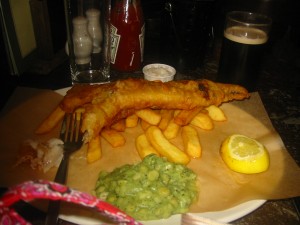 It was actually the best fish and chips I’ve had in the city.
It was actually the best fish and chips I’ve had in the city.
Just when I thought my troubles were over, I was suddenly facing a new dilemma. DO I TIP? Is it offensive if I do? Is it rude if I don’t, especially as they’d taken such good care of me? I paid my bill with exact change and, after that was cleared away, made much of checking my phone while I reached down into my purse to get another pound coin and a piece of paper. I wrote a little note, saying simply: “Thank you!” and placed it and the coin on the table as I got my bag and prepared to go, taking the last sip of Guinness. Unfortunately, my waiter then came over to take my glass and, seeing the note, read it quickly and picked up the tip. My cheeks turned red and I feared I was about to face the biggest monster of English behaviour- the cold shoulder combined with the dislike of money! I needn’t have worried, as it turns out: my waiter looked me straight in the eye and said gratefully “Oh, thank you! That was very nice of you” in an accent that was clearly not British and hinted that he too was a stranger in this strange country where money is considered dirty. Relieved to have not caused offence, I gushed “Oh, well, phew! I’m still trying to learn how all this *gesturing around, indicating the pub* works”
He smiled at me and said “Me too.”
So now the pub is not a location I visit petrified with terror, but I still prefer the peace and quiet of casual drinks with friends or at a restaurant then entering the realm of the pub, laden with social booby-traps as it is.
Categories: 2010 Elizabeth · Pubs
After reading the title of this post, anyone not familiar with our class wiki may be expecting an intellectual argument for or against the book 1984, or any of Orwell’s other great works. Instead, I’m going to talk about alcohol, specifically the drinking of it. Actually, I lied, kind of. I’m in fact preparing to discuss an essay that Orwell wrote called The Moon Under Water (for those who haven’t read it, here’s the link: http://www.netcharles.com/orwell/essays/moon-under-water.htm), which discusses the characteristics of the perfect pub in Orwell’s eyes. So, this post won’t be so much about drinking as it will be about the venues for drinking (which should make a lot of people happy, especially my parents).
In case you’re too lazy to read Orwell’s very brief, but very interesting essay, I’ll summarize it for you. Basically, Orwell describes a pub, which we later find out is fictional, that has ten qualities that make it perfect. These are:
1. The architecture is Victorian.
2. Darts are only played in the public part of the bar, which allows people to drink without having to duck.
3. The pub is quiet enough to talk, with no radio or piano.
4. Barmaids that know their customers by name and take an interest in them.
5. The bar sells tobacco and cigarettes, in addition to booze.
6. There is a snack counter that serves “liver-sausage sandwiches, mussels, cheese, pickles and […] large biscuits with caraway seeds.”
7. Six days a week, they serve lunch — for example, a cut off the joint, two vegetables and boiled jam roll.
8. “[…] a creamy sort of draught stout […].”
9. Extreme care is taken with their drinking vessels and they never, for example, make the mistake of serving a pint of beer in a handleless glass.
10. A large garden.
Looking at this essay 64 years after it was written, some of these things look like no-brainers that are characteristic of every modern pub (like a dart board being out of the way, or the pub having a nice stout) and some seem just silly, like beer not being served in a handleless glass or a pub having a garden. Despite these, if I were to characterize my ideal pub (which I’m going to) I would have to say that it would have all of these characteristics, except for numbers 5 and 9, and maybe number 1. Being completely unable to imagine a Victorian pub (mostly because when I think of “Victorian” buildings, I can only think of my aunt and uncle’s stuffy, uncomfortable Victorian-decorated houses), I don’t really know if that kind of decor is important to me or not. However, I’m going to assume that a Victorian pub looks like a stereotypical English pub, which, if true, would mean that Victorian architecture is definitely an important trait of a great pub. A pub just wouldn’t be a pub without being really dark at all times of the day, with dark wooden walls, a couple of old looking paintings, etc.
Unfortunately, I haven’t really found a pub that matches all of the criteria. Most pubs are so loud at any time of the day that it’s impossible to hold a proper conversation without yelling, and I’ve never seen a pub with a garden. However, I have found one pub that gets pretty darn close to my ideal. Sadly, I only discovered it today, so I won’t have much time to go back. It probably has the best name for a pub, at least in the opinion of the part of me that loves Shakespeare, because it is called The Globe, despite being nowhere near the famous theatre, being instead located very near the Covent Garden Market. Forgetting the garden requirement because no pub nowadays has a garden and number 4 because I’ve only been there once (though the staff seem nice), The Globe meets all of my criteria, if I understand what a Victorian pub looks like. I don’t even think they own a dartboard, which means they pass number 2 by default, and the pub was almost silent when we were there, which is a rarity that is much appreciated when it is seen. They seem to have a very nice menu, though the four of us (the members of the Origins of Rock and Roll in London tour group, a.k.a The Fab Four) only got an order of chips, food-wise. They have Guinness (a stout), which is really the only beer I ever need, and they seem to take care of their drinking glasses rather well. Therefore, I guess if I needed to pick a “favourite” pub, it would be The Globe.
Now to take a different tact on the same basic theme, I guess I’ll briefly discuss the hidden rules of pubs, which are only truly hidden for any of us who haven’t read Kate Fox (which I hope is not many, if there are any at all, because it is a wonderful, though sometimes inaccurate book). Today was actually my first experience buying drinks in rounds (technically round), so I can’t really talk much about this ritual from experience, but it seems to happen, as Fox said it does. The basic principle for those who don’t know is that when a group is out drinking, people will take turns going up to the bar to buy drinks for the group instead of ordering individually. There are, of course, many variations, but that’s the basic idea. Another important rule is that of buying the bartender a drink rather than tipping him or her. Because I never drink a lot when I go out, I’ve never really done this, because it makes much more sense if he or she has given you a few drinks, rather than just one. In fact, the only time that I was part of a group that tried to buy a bartender a drink, she refused it (it was lunchtime and she wasn’t English, which probably makes a difference). Therefore, I really can’t speak to the validity of this particular rule. Those are really the only two rules that I remember observing (or not observing) in my limited pub experiences. If anyone with more experience can think of anymore, please let me know!
Categories: 2010 MatthewM · Pubs
September 19, 2010 · 1 Comment
Note: much of the following appears, verbatim, in this Thursday’s Dickinsonian. The formatless-format is explained there, but the manner in which it is done there is incongruous with this blog.
As our syllabus eloquently says, “London is too vast—as both a place and an idea—to grasp it all.” Conveniently, it’s more my style anyway to tell a few short anecdotes and leave it to the reader to weave them together rather than give one lengthy narrative.
That said, here are a few random moments that I’ll remember well after we’re back in the states.
On a subway ride back from Westminster one Sunday, a large man wearing a suit and tie (although his collar was covered in food) came up ranting and raving to our group of four Americans. “That guy sitting next to me over there was [fondling] his girlfriend! I don’t care if you do it a hundred times at home, but not on the f**king Tube! I AM TRYING TO CONCENTRATE!” It should be noted that this man, allegedly deep in concentration, was not reading, working, or listening to music. He was simply “trying to concentrate.” At first, I found this hilarious. But the more I thought about it, the more I thought it articulated the philosophy of the stoic and silent Brits we see every day on the Tube. Many do not read, many do not listen to music. But all do not speak to or make eye contact with each other. They’re just trying to concentrate.
_______
British women, or at least women in London, are really tall.
_______
We’ve taken all kinds of tours. We’ve toured places: Westminster Abbey, St. Paul Cathedral, the University of Oxford, Greenwich, Bloomsbury, the East End, and Stratford. We’ve done tours with themes: Marx’s London, Roman London, Restoration London. As Pat put it, though, “I’d like to take a trash cans, bathrooms, and water fountains tour, as there are none of those things in this city.” You can walk for miles in Westminster and not see a single trash can; they have all been removed from the area around Parliament and the prime minister’s residence because of susceptibility to terrorist attacks.
_______
Things in London close very early by American standards. Most restaurants outside of Burger King and McDonald’s are closed by 9:00 (or, as it’s known here, 21:00) and earlier on Sundays. So it was a major pleasant surprise when a few of us found a Subway that was open nightly until 5:00 AM. But it was extremely bewildering? Why this Subway, when four more from the same chain within two miles close around the usual London time?
This mystery was solved when it was realized that there was a strip club across the street that was open until 4:00 AM nightly.
Categories: 2010 Dennis · Uncategorized















